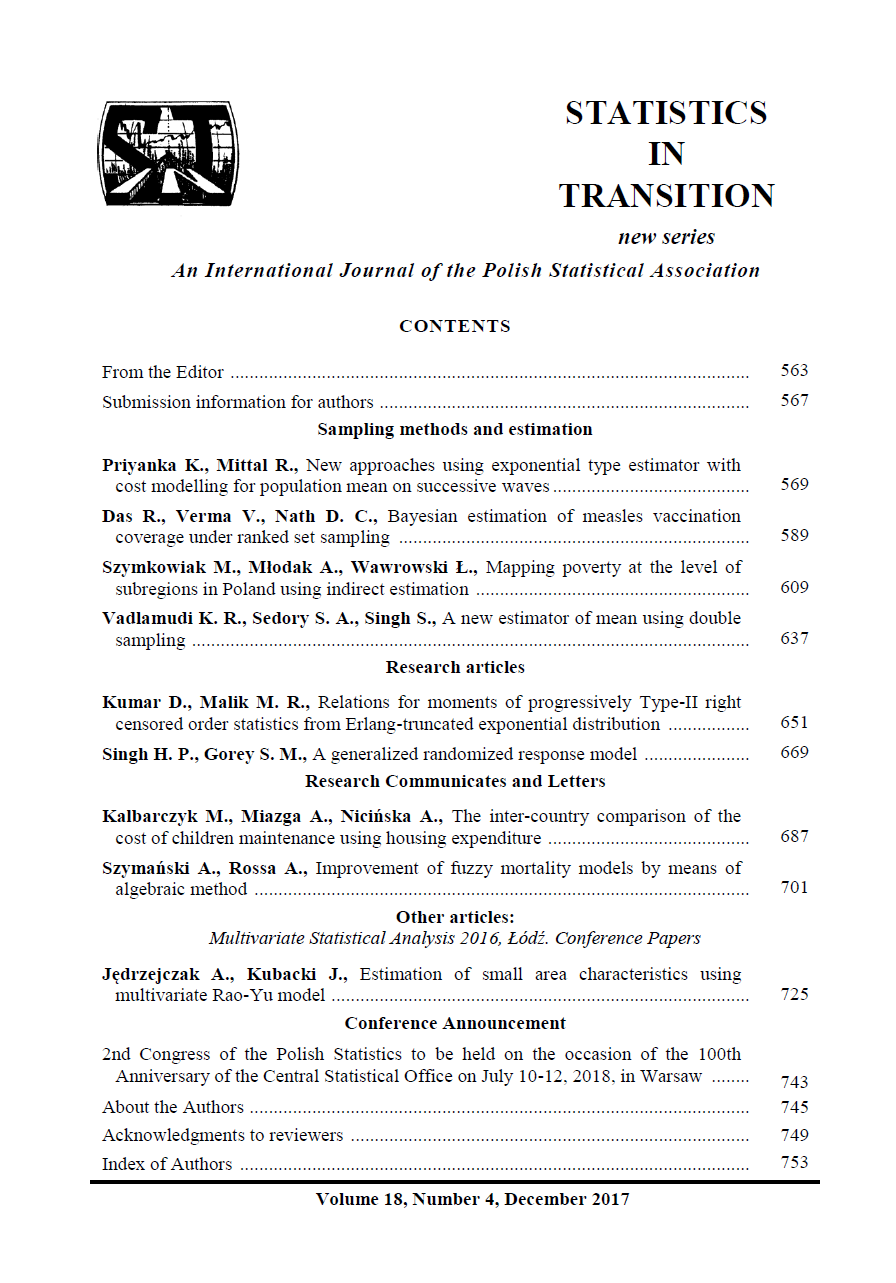ARTICLE
ABSTRACT
The key and fundamental purpose of sampling over successive waves lies in the varying nature of study character, it so may happen with ancillary information if the time lag between two successive waves is sufficiently large. Keeping the varying nature of auxiliary information in consideration, modern approaches have been proposed to estimate population mean over two successive waves. Four exponential ratio type estimators have been designed. The properties of proposed estimators have been elaborated theoretically including the optimum rotation rate.Cost models have also been worked out to minimize the total cost of the survey design over two successive waves. Dominances of the proposed estimators have been shown over well-known existing estimators. Simulation algorithms have been designed and applied to corroborate the theoretical results.
KEYWORDS
Successive sampling, Exponential type estimators, Dynamic ancillary information Population mean, Bias, Mean squared error, Optimum rotation rate
REFERENCES
BANDYOPADHYAY, A., SINGH, G. N., (2014). On the use of two auxiliary variables toimprove the precision of estimate in two-occasion successive sampling, Int. J. Math. Stat., 15, pp.73–88.
ECKLER, A. R., (1955). Rotation Sampling, Ann. Mathe. Stat. 26, pp. 664–685.
SEN, A. R., (1971). Successive sampling with two auxiliary variables. Sankhya, B 33, pp. 371–378.
SEN, A. R., (1972). Successive sampling with p ?p 1 ? ? auxiliary variables. Ann. Math. Statist. 43, pp. 2031–2034.
SEN, A. R., (1973). Theory and application of sampling on repeated occasions with several auxiliary variables. Biometrics, 29, pp. pp. 381–385.
SINGH, G. N., (2005). On the use of chain-type ratio estimator in successive sampling. Statistics in Transition 7, pp. 21–26.
SINGH, G. N., PRIYANKA, K., (2006). On the use of chain-type ratio to difference estimator in successive sampling. I. J. App. Math. Statis., 5, pp. 41–49.
SINGH, G. N., PRIYANKA, K., (2007). Effect of non-response on current occasion in search of good rotation patterns on successive occasions, Statist. Trans. New Ser. 8, pp. 273–292.
SINGH, G. N., PRIYANKA, K., (2008). Search of good rotation patterns to improve theprecision of estimates at current occasion, Comm. Stat. – Theo. Meth. 37, pp. 337–348.
SINGH, G. N., KARNA, J. P., (2009). Search of efficient rotation patterns in presence of auxiliary information in successive sampling over two occasions. Statis. Tran. N. Ser. 10, pp. 59–73.
SINGH, G. N., PRASAD, S., (2010). Some estimators of population mean in two occasion rotation patterns. Asso. Adva. Mode. Sim. Tech. Enter., 12, pp. 25–44.
SINGH, G. N., PRIYANKA, K., PRASAD, S., SINGH, S., KIM, J., M., (2013).A class of estimators for estimating the population variance in two occasion rotation patterns,Comm. Statis. App. Meth., 20, pp. 247–257.
PATTERSON, H. D., (1950). Sampling on successive occasions with partial replacement of units, J. Royal Statis. Soci., 12, 241–255.
SINGH, H. P., KUMAR, S., BHOUGAL, S., (2011). Multivariate ratio estimation in presence of non-response in successive sampling. J. Statis. Theo. Prac., 5, pp. 591–611.
GORDON, L., (1983). Successive sampling in finite populations, The Ann. Stat.,11, pp. 702–706.
PRIYANKA, K., MITTAL, R., (2014). Effective rotation patterns for median estimation in successive sampling. Statis. Trans., 15, pp. 197–220.
PRIYANKA, K., MITTAL, R., KIM, J., M., (2015). Multivariate Rotation Design for Population Mean in sampling on Successive Occasions.Comm. Statis.Appli. Meth., 22, pp. 445–462.
PRIYANKA, K., MITTAL, R., (2015a). Estimation of Population Median in Two-OccasionRotation. J. Stat. App. Prob. Lett., 2, pp. 205–219.
PRIYANKA, K., MITTAL, R., (2015 b). A Class of Estimators for Population Median in two Occasion Rotation Sampling. HJMS, 44, pp. 189–202.
SUKHATME, P. V., SUKHATME, B. V., SUKHATME, S., ASOK, C., (1984).Sampling Theory of Surveys with applications. Ames, Iowa State University Press and New Delhi India, Indian Society of Agricultural Statistics.
ARNAB, R., OKAFOR, F. C., (1992). A note on double sampling over two occasions, Paki. J. Stat., 8, pp. 9–18.
NARAIN, R. D., (1953). On the recurrence formula in sampling on successive occasions, J. Indi.Soci. Agri. Stat., 5, pp. 96–99.
JESSEN, R. J., (1942). Statistical investigation of a sample survey for obtaining farm facts, IowaAgri. Exp. Stat.Road Bull., 304, pp. 1–104.
BIRADAR, R. S., SINGH, H. P., (2001). Successive sampling using auxiliary information on both occasions, Cal. Statist. Assoc. Bull., 51, pp. 234–251.
SINGH, R., SINGH, N., (1991). Imputation methods in two-dimensional survey.Recent Advances in Agricultural Statistics Research, Wiley Eastern Ltd, New Delhi,.
SINGH, V. K., SINGH, G. N., SHUKLA, D., (1991). An efficient family of ratio cum difference type estimators in successive sampling over two occasions. J. Sci. Res., 41, pp. 149–159.
FENG, S., ZOU, G., (1997). Sample rotation method with auxiliary variable, Comm. Stat.- Theo. Meth., 26, pp. 1497–1509.
COCHRAN, W., G., (1977). Sampling Techniques, John Wiley & Sons, New Delhi
